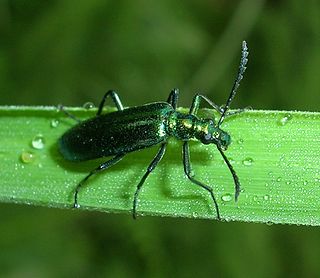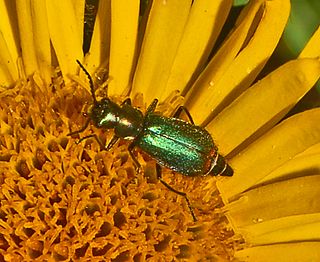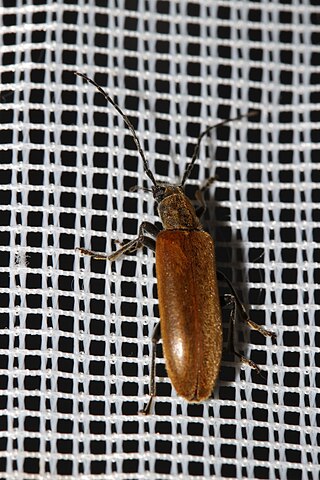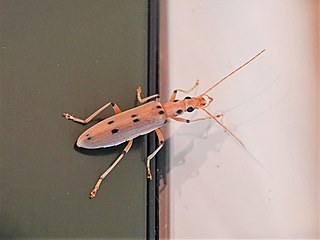
Melyridae are a family of beetles of the superfamily Cleroidea.

Prionoceridae is a small family of beetles, in the suborder Polyphaga. They form a group within the cleroid beetles and were formerly treated as a subfamily (Prionocerinae) within the family Melyridae. Very little is known of their life history but most species are pollen feeders as adults and occur in large numbers during spring or the host flowering season. Larvae are predatory or feed on decomposing wood.

An interdunal wetland, interdunal pond or dune slack is a water-filled depression between coastal sand dunes. It may be formed either by wind erosion or by dunal encroachment on an existing wetland. The wind erosion process involves wind scooping out sufficient sand to reach the water table, and typically occurs behind the first line of foredunes.

Malachius is a genus of soft-winged flower beetles belonging to the family Melyridae subfamily Malachiinae. Malachius species have been reported from Albania, Belgium, Bulgaria, Czech Republic, France, Germany, Hungary, Italy, Poland, Spain, Sweden, Switzerland and in former Yugoslavia.
Pollen beetle is an informal term for any species of beetle associated intimately with suitably pollen-rich species of flowers. Typically such a beetle is adapted to the pollen as a major part of its diet. Species in at least sixteen families of the order Coleoptera could be counted as pollen beetles, and "pollen beetle" also is a common name for some such species.

Clanoptilus is a genus of beetles belonging to the family Melyridae.

Asclerini is a tribe of false blister beetles in the family Oedemeridae. There are more than 40 genera and over 200 described species in Asclerini.
Endeodes is a genus of soft-winged flower beetles in the family Melyridae. There are about six described species in Endeodes.

Sparedrus is a genus of false blister beetles in the family Oedemeridae. There are more than seven described species in Sparedrus.

Nacerdes is a genus of false blister beetles in the family Oedemeridae. There are about 40 described species in Nacerdes.

Antonín Fleischer was a Moravian and Czech physician and entomologist who specialized in beetles.

Ischnomera is a genus of false blister beetles in the subfamily Oedemerinae.

Anthocomus is a genus of beetles in the family Melyridae. The species of this genus are found in Europe and North America.

Cordylepherus is a genus of beetles belonging to the family Melyridae. The species of this genus are found in Europe.

Hypebaeus is a genus of beetles belonging to the family Melyridae.
Ceratistes is a genus of beetles belonging to the family Melyridae.
Ablechrus is a genus of beetles belonging to the family Melyridae.
Apalochrus is a genus of beetles belonging to the family Melyridae.
Brachemys is a genus of beetles belonging to the family Melyridae.

Parisopalpus is a genus of false blister beetles in the family Oedemeridae. The genus was first identified by Logan Hudson in 1975, who separated the group from Sessinia due to the presence of bifid mandibles, and n males of the species visible genitalia.














